The biggest entertainment stories
Get our big stories about Hollywood, film, television, music, arts, culture and more right in your inbox as soon as they publish.
You may occasionally receive promotional content from the Los Angeles Times.
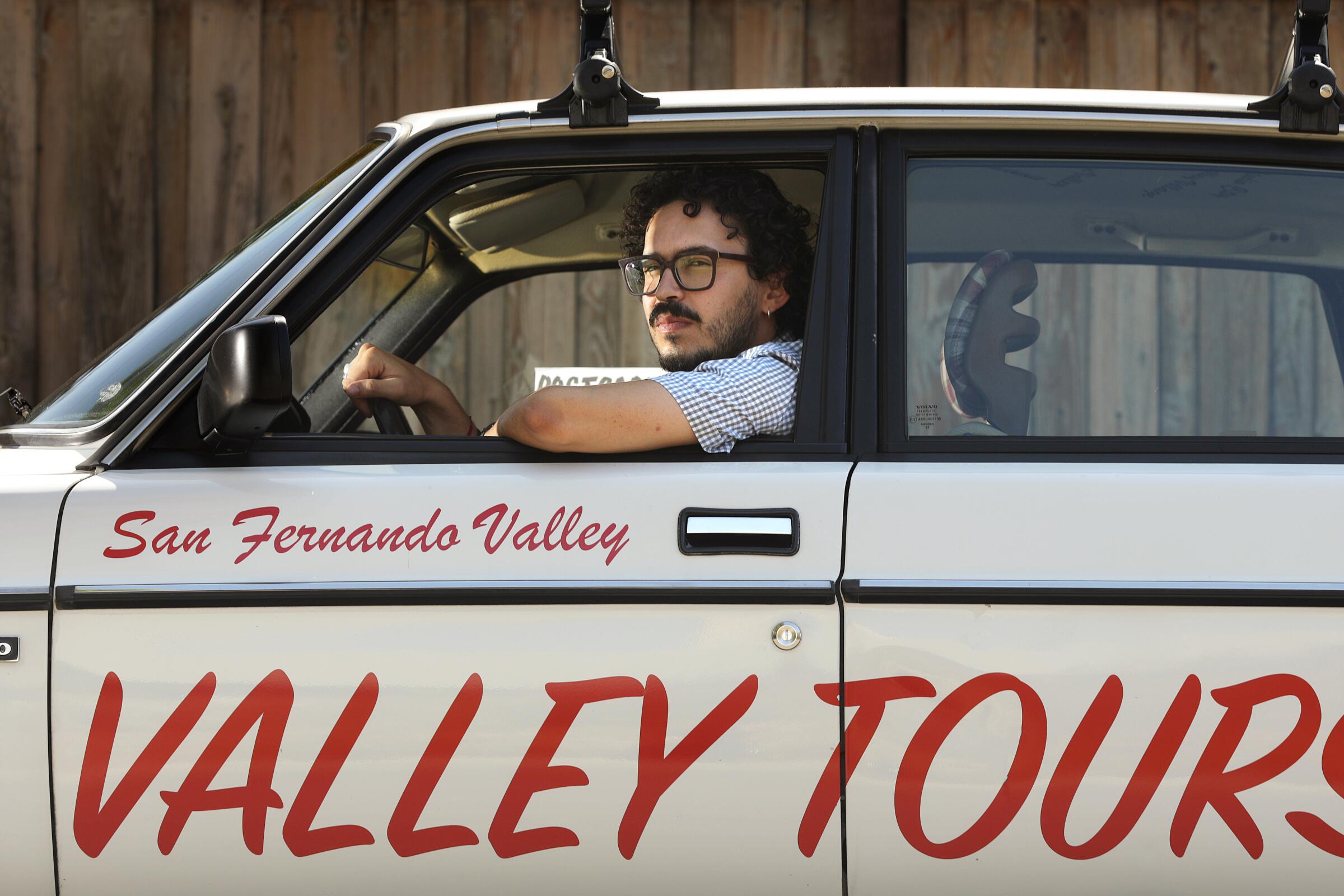
The tour begins with a runaway tortoise.
We’re in Vincent Enrique Hernandez’s 1987 Volvo cruising through his Van Nuys neighborhood, a grid of sun-scorched streets, spiky palm trees and suburban ranch homes. The teenage tortoise lives at a neighbor’s house and is sleeping at the moment, but it’s something of an escape artist. Once, it was found sauntering across Hazeltine Avenue, about a quarter mile from home.
It’s idiosyncratic tidbits like this that give the neighborhood color and fuel Hernandez’s affection for the San Fernando Valley, where he grew up.
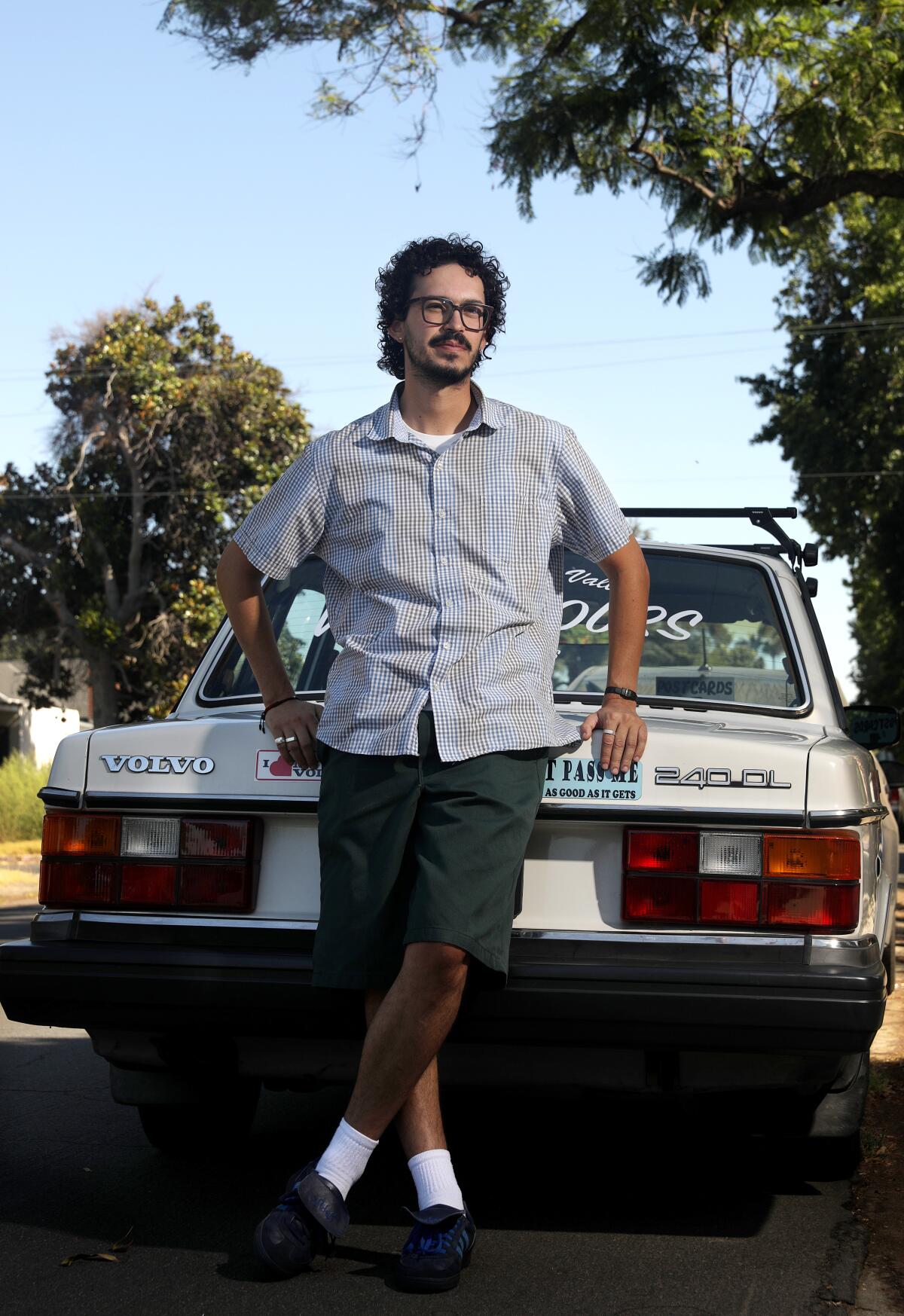
The 24-year-old artist’s upcoming Hammer Museum presentation — part of the “Made in L.A. 2023” biennial, opening Oct. 1 — takes on misconceptions about the Valley. As part of the project, which also includes a gallery exhibition at the museum, Hernandez will lead selected visitors on an immersive, five-hour-long tour of the Valley in his Volvo. The tour — stretching as far northeast as Sylmar, as far southwest as Winnetka and as far southeast as Studio City and covering about 75 miles — spans historical sites, public art, iconic signage and Valley-specific architecture as well as Hernandez’s personal memories, favorite burger and sushi spots and insider lore, among other things.
“This isn’t a Hollywood sightseeing tour where you’re gonna see all these things from the big screen,” he says from behind the wheel, one arm outstretched and pointing to the Circus Liquor store’s famous neon clown sign. “A lot of this stuff is the stuff that slips between the cracks or is under your nose.”
The 36-year-old Volvo sports a plush, camel-colored interior, handmade plaid seat cushions and has logged 400,000 to 500,000 miles (the odometer was broken for years, and is now fixed, so it’s Hernandez’s best guess). A loose soccer ball rolls around on the floor below what would be the front passenger seat, except that the seat is missing. Hernandez took it out to make room for an upright, spinning postcard rack. It’s filled with $1 postcards for sale, featuring Hernandez’s photography of the Valley, all points of interest on the tour.
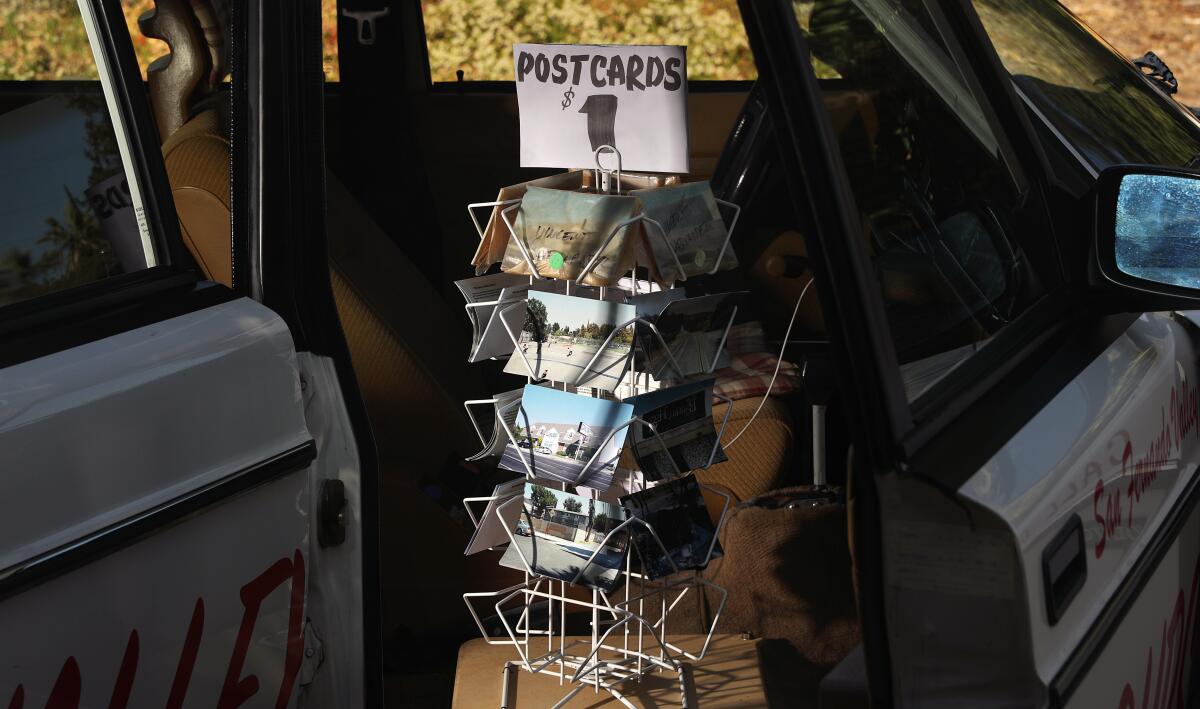
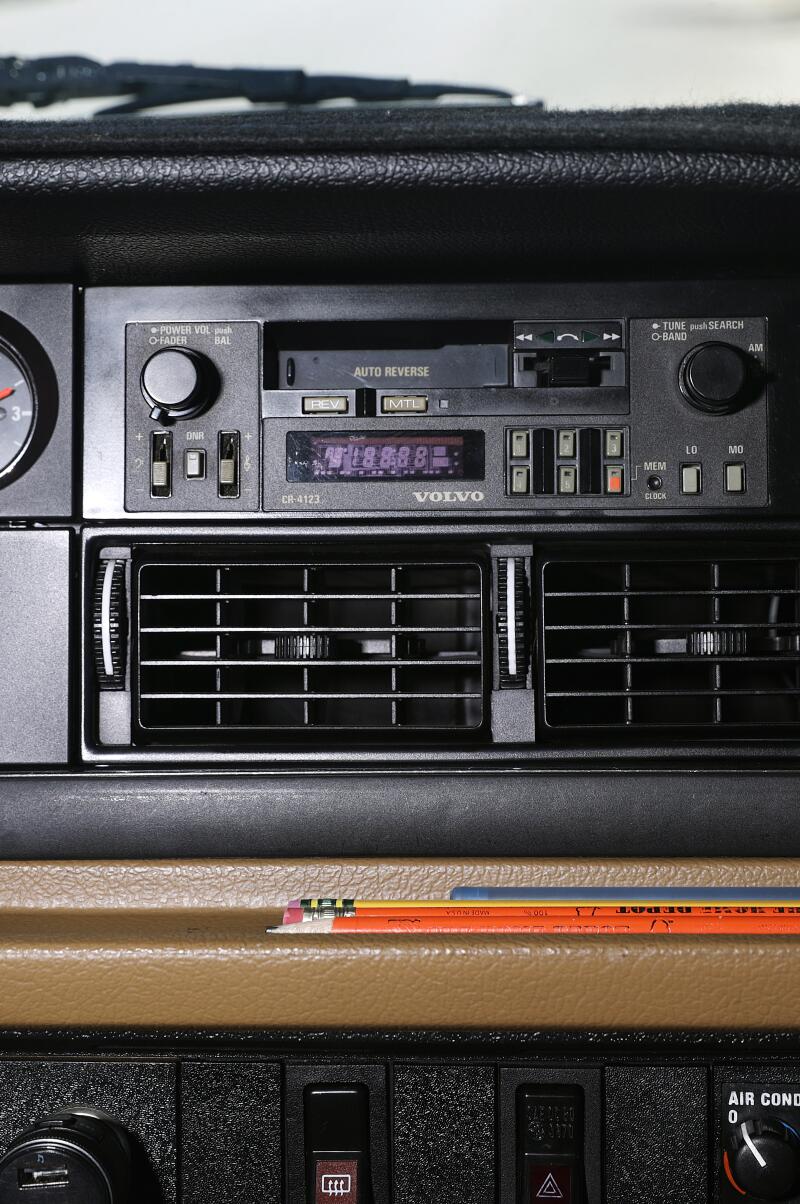
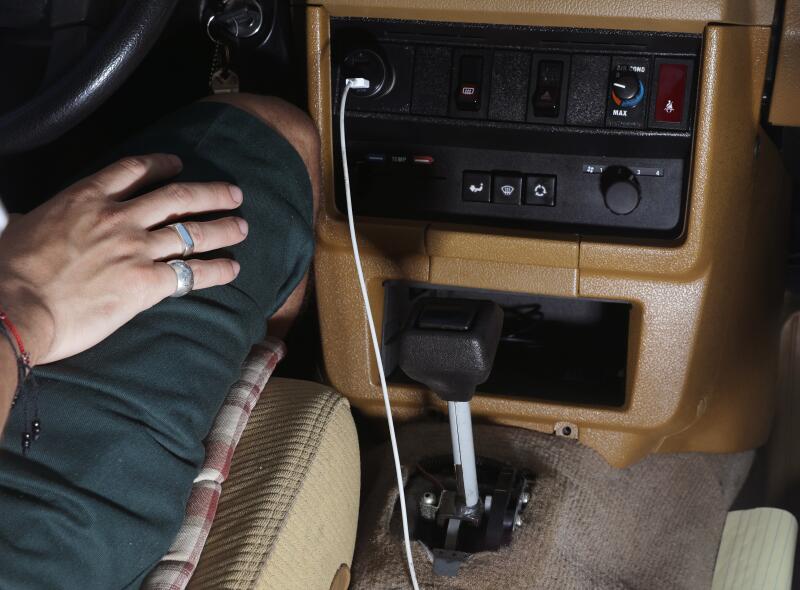
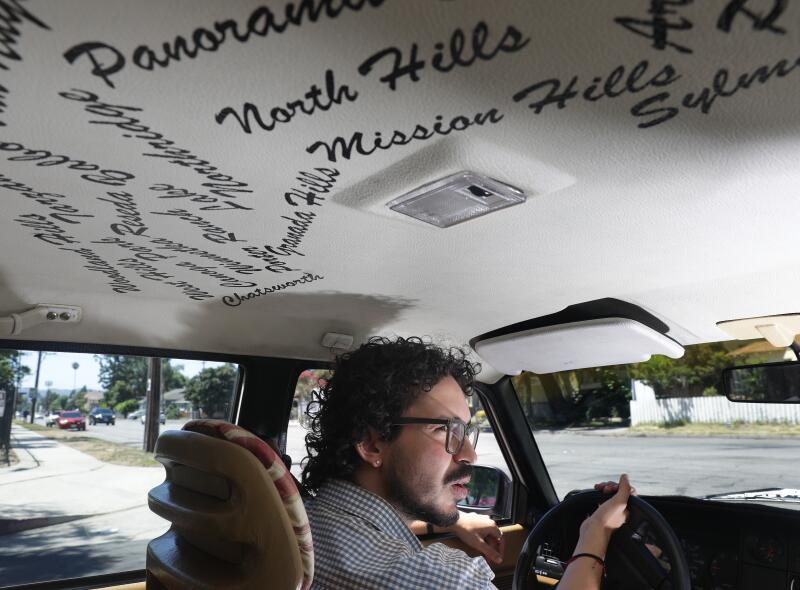
Inside Hernandez’s Volvo. (Christina House / Los Angeles Times)
“I love that people can look at the art and touch it and play with it and then take something home — art that doesn’t cost thousands of dollars,” he says. “It’s an accessible thing.”
The tour itself stretches the boundaries of art. This year’s biennial — “Made in L.A. 2023: Acts of Living” — taps into “L.A. histories and strands of culture,” says co-curator Diana Nawi. The tour, a sustained, interactive “over-performance,” as Hernandez describes it, is part of a larger body of work that includes photography, performance, printed work and sculpture. It nods to a long history of conceptual art projects in L.A., Nawi says. The project also fits squarely into the biennial’s overriding theme: What could be more related to “Acts of Living” than a personal tour, led by a local, of an important swath of L.A.?
Hammer’s ‘Made in L.A.’ biennial paints cross-generational picture
“The intimacy, the storytelling, the adjacency to the artist is part of the art experience,” Nawi says.
Hernandez puts it more simply: “Conventional materials aren’t my forte.”
That the tour is executed with a strong point of view — “a certain level of intent and criticality,” Hernandez says — puts it in the realm of art, in his view. “It’s the juxtaposition of all these objects and tools — more of a think tank on wheels.”
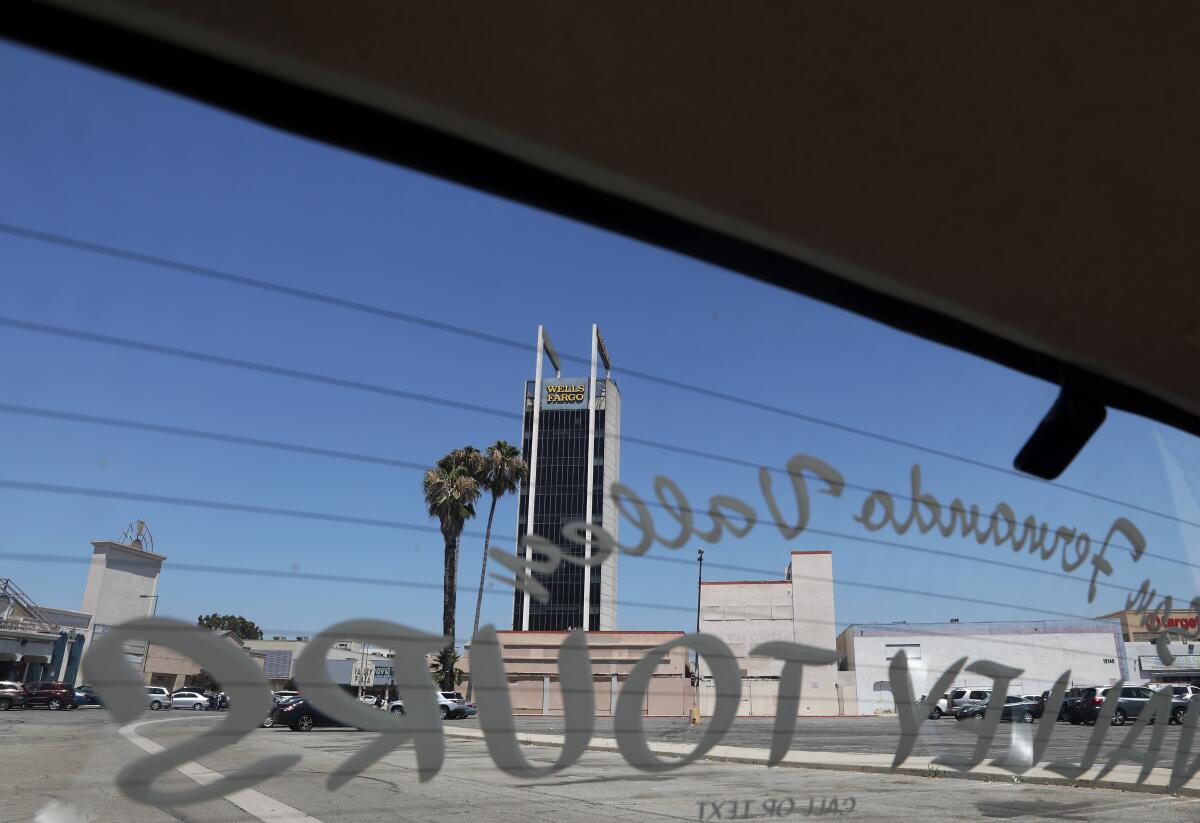
We pass sushi row on Ventura Boulevard, one of the highest concentrations of sushi restaurants, Hernandez says, outside of Japan, as well as an apartment building that was once the Oxwood Inn, one of the longest running lesbian bars in the country (1972-2017).
Images on the postcard rack mirror our surroundings. Top rack: the world’s first skateshop, Val Surf. Center rack: a Winnetka house featuring a pirate ship mast in its driveway. Bottom rack: the tortoise, crossing a sun-singed lawn.
Photography is central to Hernandez’s project. He gives all his passengers disposable cameras to snap whatever captures their interest during the tour. He includes many of their pictures — grainy, off-centered shots of Valley architecture or passing cars or selfies — in a binder that will be on view in the exhibition. It serves as an evolving visual journal of the project. Hernandez hopes to incorporate his postcard images into a book at some point.
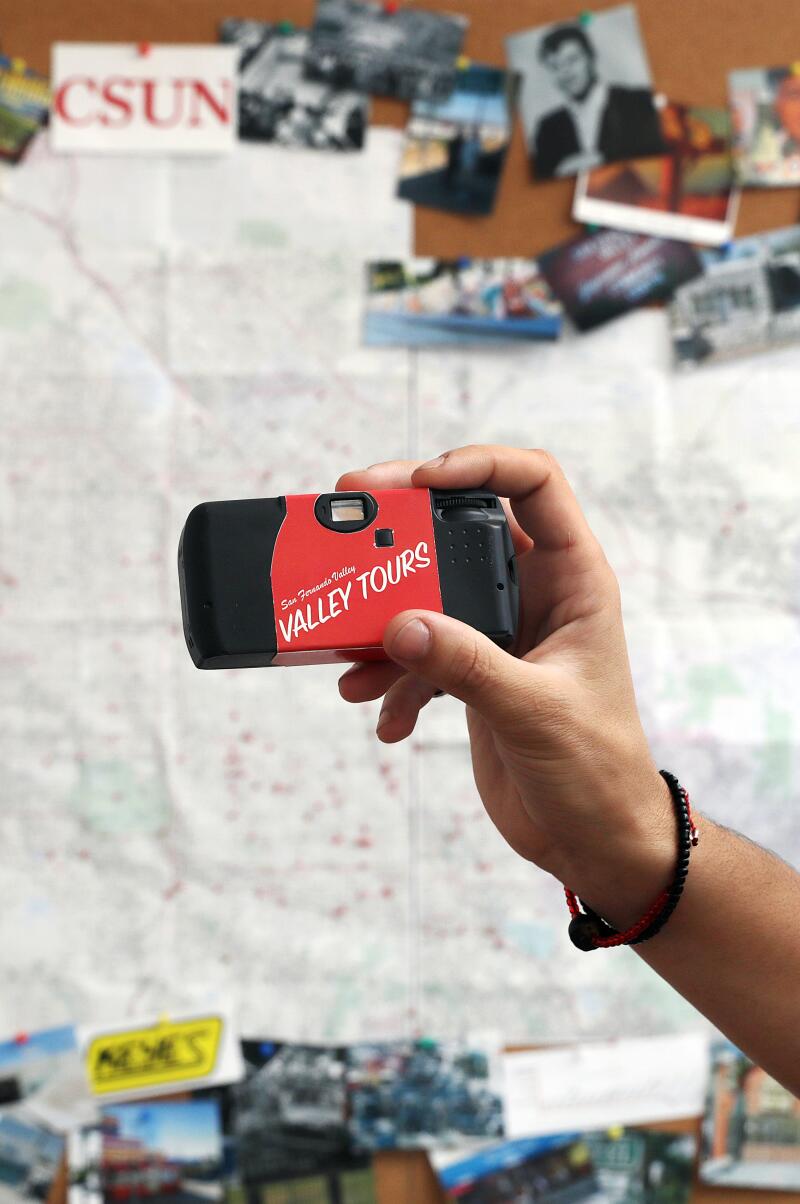
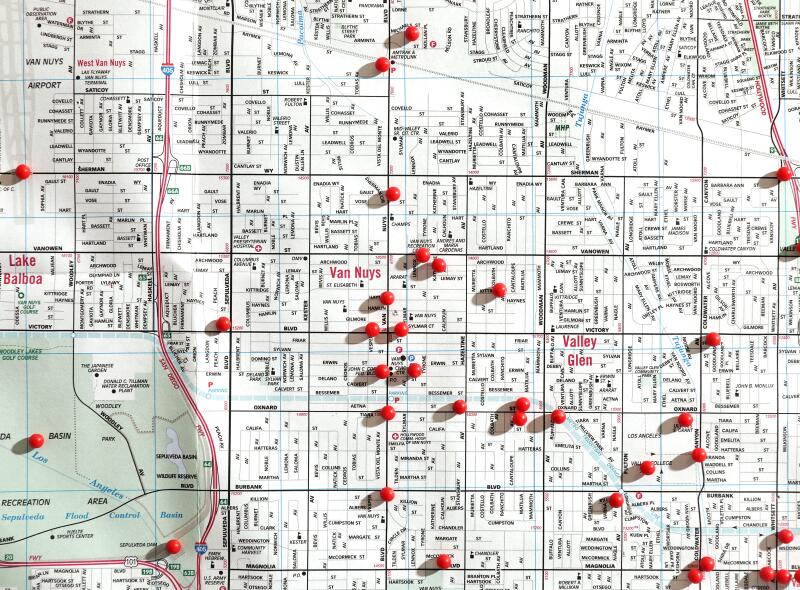
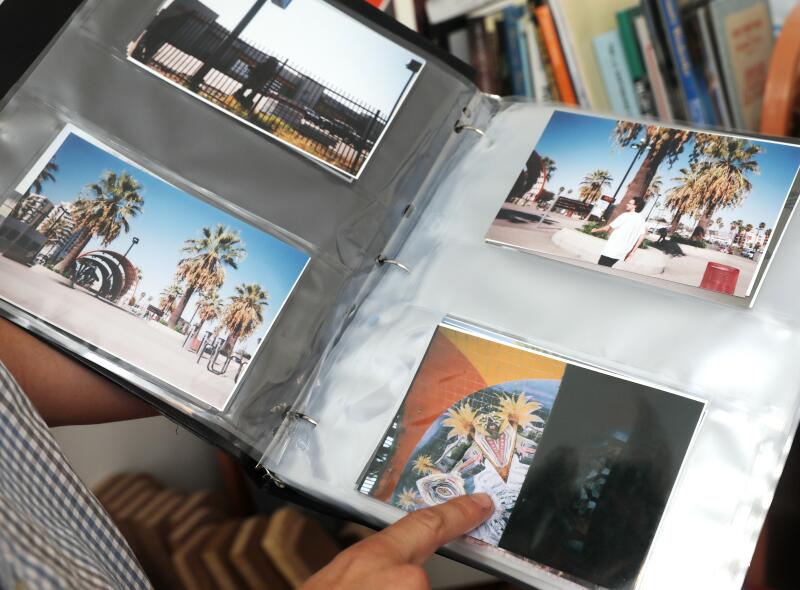
From left: A disposable camera that Vincent Enrique Hernandez gives passengers. The artist’s tour map. An evolving visual journal of the conceptual art project. (Christina House / Los Angeles Times)
“Materiality” also plays a key role in the project, says Hernandez, who graduated from the California Institute of the Arts in 2021. He’s now studying sign painting and has adorned his car with decals he designed. Across the car’s exterior, it reads, “Valley Tours,” along with a phone number and “$1 Postcards.” A sticker he designed says, “How’s My Driving?” Inside, the ceiling of the car is plastered with names of Valley neighborhoods. He and his mother designed the hand-sewn seat cushions. And Hernandez is building a custom stand for the exhibition, an interactive sculpture of sorts, in which Hammer visitors will drop raffle tickets. Hernandez will select a winner each week — capped at 13 draws — to take the tour. (No other tours will be offered during the run of the exhibition.)
At Judith F. Baca’s iconic North Hollywood mural, “The Great Wall of Los Angeles,” Hernandez parks his Volvo and gets out, skateboard secured under his arm. Typically, he drops passengers off here, at one end of the half-mile-long mural, then he drives to the other end and parks. He then skateboards back to the tour members, walking the rest of the way with them while offering information about the mural. Since today’s tour is a truncated version, however, we climb back into the car and move on.

Hernandez developed the tour for his junior year exhibition at CalArts. The first tours took place in fall 2019, with friends and friends of friends as passengers. Hernandez was inspired by the catalog from a 2014 exhibition, “Valley Vista,” at Cal State Northridge, as well as the “fearlessness and interactivity” of performance artist Andrea Fraser and the “everyday target audience” of artist David Hammons. Since 2019, he’s led about half a dozen tours in all. Which isn’t a lot, he admits, noting that he took a two-year break during the pandemic. “And it is five hours,” he adds. “Plus, there’s not that much interest in taking a tour of the Valley, given its reputation.”
At traffic lights, as Hernandez’s Volvo winds its way through the Valley, other drivers often stare; on the freeway, they might honk or yell out of the window at his text-wrapped car. Once, someone yelled, “I’m moving back to my hometown, and I wanna buy some postcards!” So Hernandez pulled over and the woman bought several. Occasionally, someone will call Hernandez while still in their car: “‘Hey, I saw your car on the freeway. I wanna take a tour,’” he says.
Hernandez, who works at the Fowler Museum at UCLA part-time as an exhibition preparator, makes art in his home studio, a spare bedroom in his parents’ house, the house he’s lived in since he was 3, in which he still lives. His parents are originally from Venezuela — his father is a TV news videographer and his mother is an artist — and the house is filled with art on the walls, tabletops, even in the bathtub.
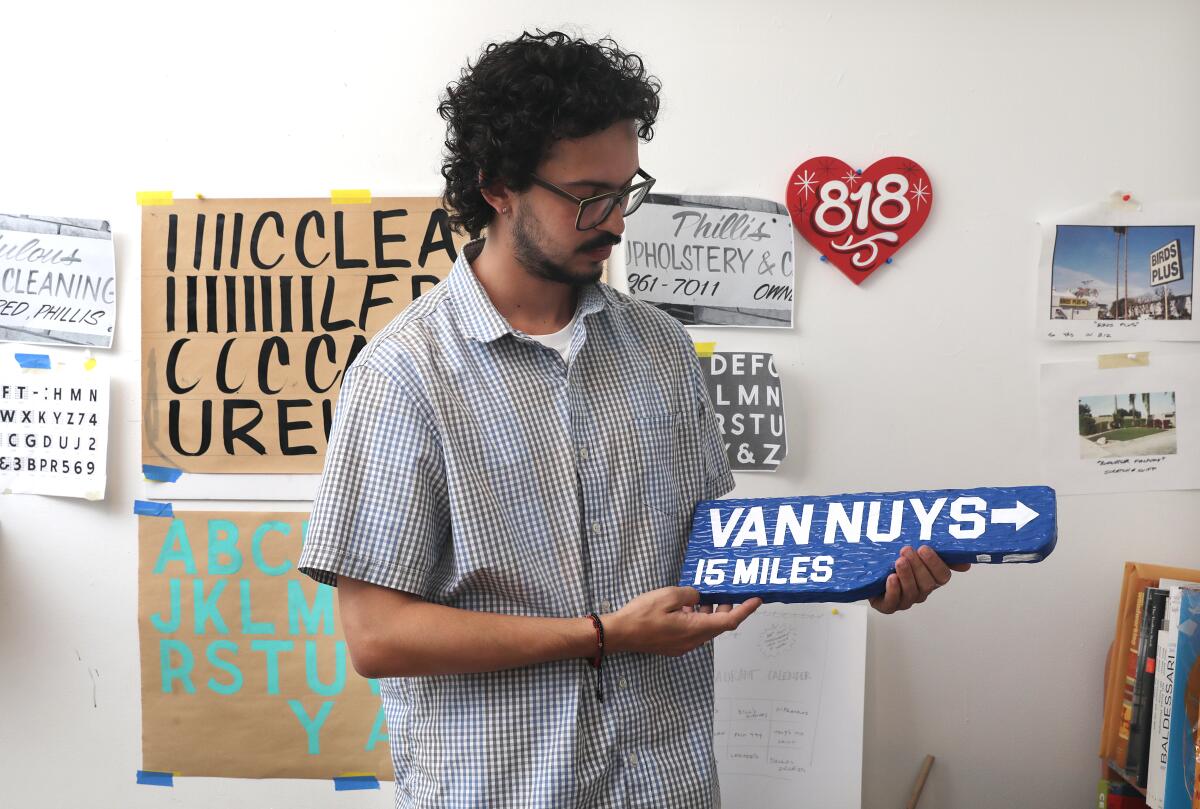
His art studio is brimming with colorful memorabilia, a testament to his love of the Valley as well as his appreciation for history and nostalgia and collecting; he collects Valley business cards and fortune cookie musings and used to collect bottle caps. A sprawling map of the Valley, on the wall, is dotted with pins marking points of interest on the tour and postcards Hernandez has yet to shoot. Part research tool, part inspirational vision board, the map is surrounded by images he’s sourced from the internet, including Baca’s mural, the Pacoima-born Ritchie Valens and Britney Spears in a velour tracksuit. “Juicy Couture is from the Valley,” he says. The map will be on view in the exhibition.
Not everything on the tour is positive — it’s “a loving gesture,” Hernandez says, but honest. The tour includes the site of a violent 1997 shootout between two bank robbers and police officers in North Hollywood as well as the epicenter of the 1994 Northridge earthquake.
The local 7-Eleven is the meeting place, watering hole and cultural center of the San Fernando Valley.
Noticeably absent: Hollywood and celebrities. Hernandez might point out obvious landmarks, such as the neighborhood of Reseda, where the movie “The Karate Kid” is set. But for the most part, it’s devoid of Hollywood sparkle.
One exception: On the Ritchie Valens Memorial Highway, Hernandez plays “La Bamba,” animating the car cabin with the late singer’s hit. Audio elements such as this factor into the journey, periodically. Driving along Van Nuys Boulevard Auto Row, he plays the Keyes on Van Nuys radio jingle.
The tour comes to a climax when we reach the lookout point atop Mulholland Drive. The Valley unfurls below, ensconced in late afternoon haze.
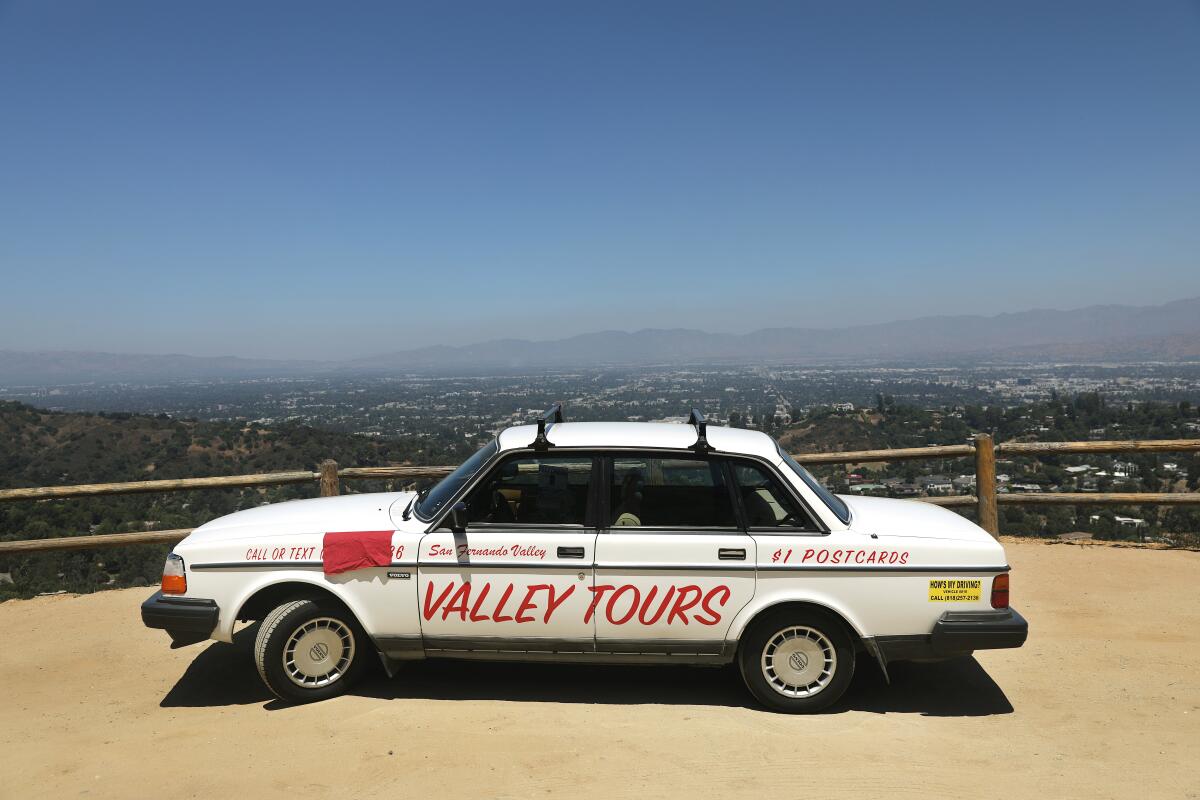
“You can see the smog separation just above the line of the mountains,” Hernandez says. “The hot air gets stuck. It’s part of a temperature inversion. I learned that from my environmental science teacher.”
On the way home, we turn onto a stretch of Burbank Boulevard. lined with doughnut shops, liquor stores and karate studios. Sugary-sounding pop punk music fills the car, a song by Los Abandoned, “Van Nuys (Es Very Nice).”
“This is the birthplace of the mini-mall,” Hernandez says of the Valley.
Corner malls and plazas could factor into upcoming postcards, he says, along with the often-graffiti’d tunnel on Sherman Way that runs under the Van Nuys Airport, the Al Struckus House in Woodland Hills and the North Hollywood building that formerly housed the California Institute of Abnormal Arts — sites that push against the cliche of the Valley as a cultural wasteland, devoid of character, the antithesis of what his tour aims to convey.
“A postcard can be a fun opportunity to tell a story of a place that you might not get otherwise,” Hernandez says of his distinctive take. “Like, who’s talking about some tortoise that ended up in somebody’s yard, down the street?”
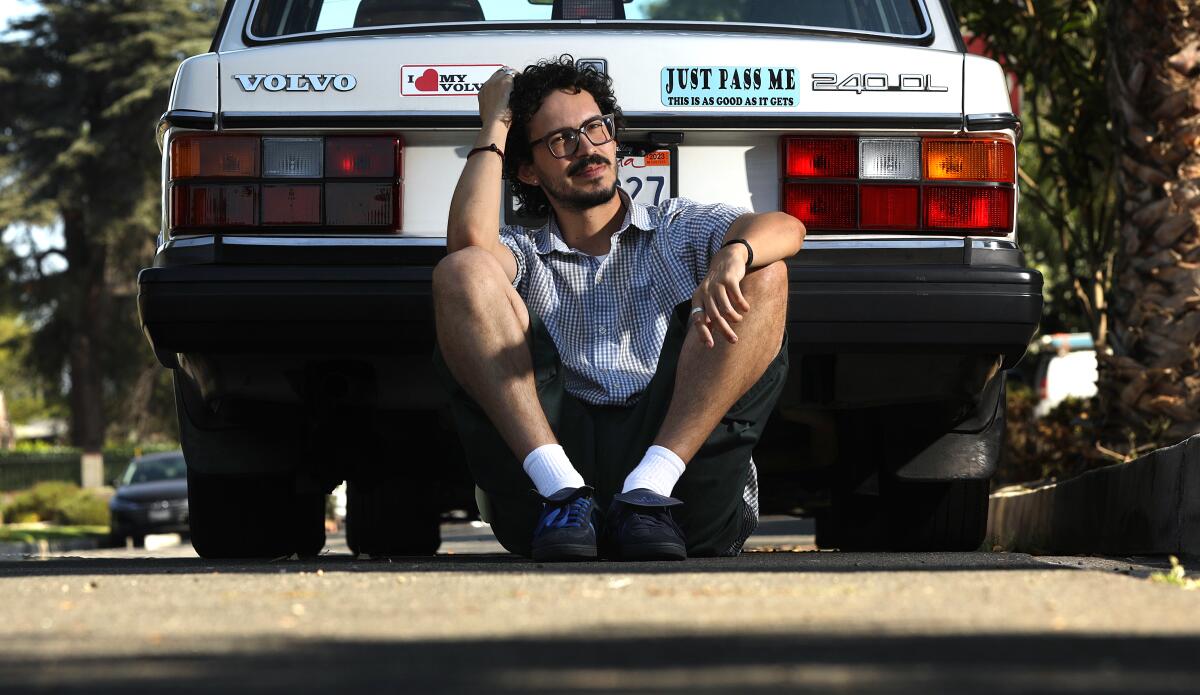
The biggest entertainment stories
Get our big stories about Hollywood, film, television, music, arts, culture and more right in your inbox as soon as they publish.
You may occasionally receive promotional content from the Los Angeles Times.